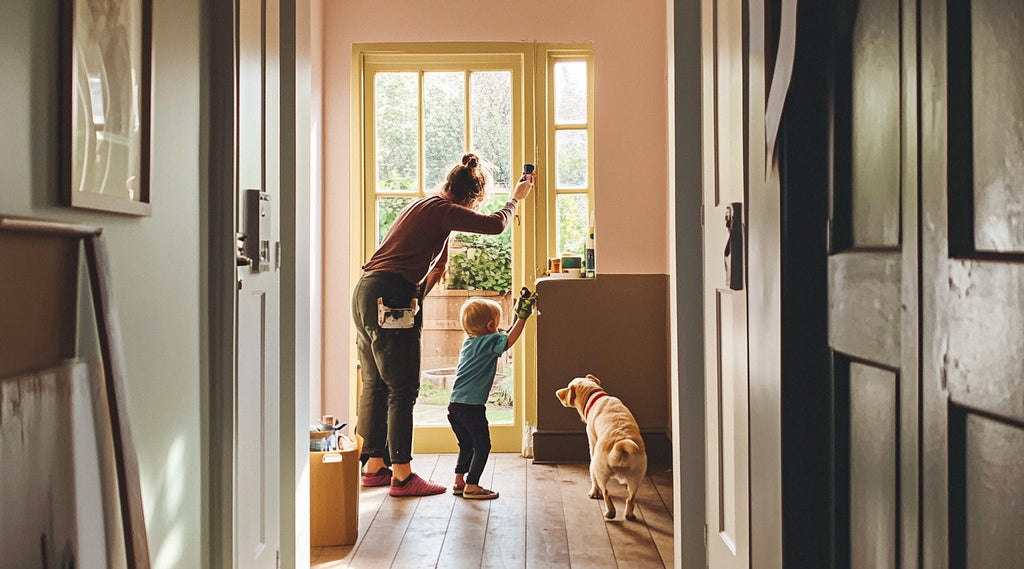You know ‘that paint smell’? That's not just the scent of DIY; it's a cloud of evaporating chemicals you really don't want in your home.
The smell is VOCs. The name is everywhere, with practically every paint brand claiming to be “low VOC”, but what exactly are they? And are they safe for you to ignore?
What exactly are VOCs?
VOCs are volatile organic chemical compounds. Historically, they were added to paint to improve its performance. For example, they act as solvents, dissolving and carrying pigments and binders, helping the application, drying time, etc: Think of them as the workhorses of traditional paint chemistry. They evaporate when the paint is applied, releasing gases into the air, which is the “fresh paint smell” you associate with decorating.
Common VOCs in paint include things like toluene, xylene, formaldehyde, and ethylene glycol (some of which are known carcinogens). These chemicals, while effective in achieving desired paint properties, are the very substances that pose the potential health risks.

That paint smell: a cause for concern?
That distinctive paint smell isn't just an aroma; it's a cloud of these evaporating VOCs. When you inhale them, they can cause a range of health issues, from headaches and dizziness to respiratory problems and even long-term health risks. Children, pets, and those with sensitivities are particularly vulnerable.
The low-VOC myth
As awareness of the danger of VOCs grew, paint manufacturers shifted focus towards 'low-VOC' water-based paints, heavily marketed as a “healthier” alternative to traditional oil- and solvent-based paints.
Most paint companies now claim 'low-VOC' options, intended to sound reassuring. However, it's crucial to understand 'low-VOC' is a long way from being 'VOC-free'. It simply indicates the paint contains less than a specific threshold of these chemicals.
Critically, it does not guarantee the most harmful VOCs have been removed.

Kids and low-VOC paints: a worrying link
Doubts on the true safety of low-VOC paints were heighted even more after studies showed that these types of paints most likely still contain PGEs (propylene glycol and glycol ethers), the main group of VOCs associated with children’s allergies and asthma.
Groundbreaking research, such as a study published by a team of scientists from Harvard University and Sweden’s Karlstad University, found children who sleep in bedrooms containing these fumes, released from drying paint, are two to four times more likely to suffer from allergies or asthma.
Little Knights: painting a healthier future
Mark Gardner, the visionary behind Little Knights, refused to accept the industry's complacent stance to these known health risks. He saw a market flooded with paints claiming 'low-VOC' safety, while the British Coatings Federation stubbornly insisted 'zero-VOC' was simply impossible.
He knew there was a better way and took matters into his own hands, defying established norms and creating Little Knights: a truly safe and beautiful paint - 100% VOC-free, odourless, antibacterial, and environmentally sound. The so-called impossible was, in fact, achievable.

We‘re doing more than creating paint; we’re challenging the status quo
We dared to do what the industry said couldn't be done, proving compromise is not a necessity and leading the way for a higher standard of safety for families everywhere.
It's simply not right that we should expose ourselves and our families to hazardous chemicals just to take pride in our homes. That's why we worked tirelessly to create a paint that isn't just 'low-VOC,' but truly 100% VOC-free. This means that at no point during the application or drying process will you be exposed to any VOCs. (Note: some companies claim '0% VOC,' but a closer look at their fine print reveals this only applies after two weeks of curing!) We are driven to create a product that is not only beautiful and durable but also completely safe for you, your family, and the environment.
Setting a New Standard
We believe that painting your home shouldn't come at the cost of your health. We’re working hard to disrupt the paint industry by showing that it is possible to create high-quality paints that are completely safe. We hope that by setting a new bar, we can inspire other companies to follow suit and prioritize the health and well-being of their customers.
We continue to hope the British Coatings Federation will adjust their stance and encourage paint manufacturers to make safer, 100% VOC-free products for the benefit of their customers.


